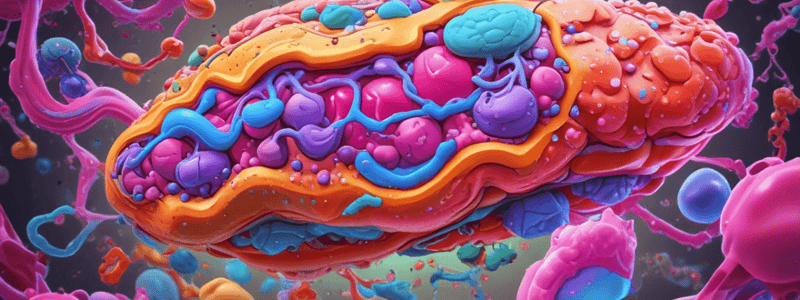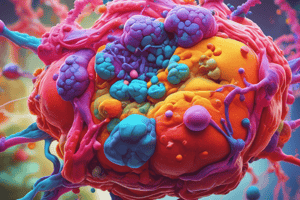Podcast
Questions and Answers
Why does the body experience osmotic diuresis in diabetes mellitus?
Why does the body experience osmotic diuresis in diabetes mellitus?
- To decrease lipolysis
- To increase glucagon release
- To excrete excess glucose via urine (correct)
- To store glucose as an energy source
What is the result of the body excreting lots of water with the urine during osmotic diuresis?
What is the result of the body excreting lots of water with the urine during osmotic diuresis?
- Low glycerol levels
- Very dilute urine (correct)
- Increased lipolysis
- High glucagon levels
In diabetes mellitus, why does the body increase thirst (polydipsia)?
In diabetes mellitus, why does the body increase thirst (polydipsia)?
- To inhibit lipolysis
- To excrete excess glucose
- To decrease glucagon release
- To replenish water lost through urine (correct)
What role does hepatic gluconeogenesis play in diabetes mellitus?
What role does hepatic gluconeogenesis play in diabetes mellitus?
How does weight loss occur in diabetes mellitus?
How does weight loss occur in diabetes mellitus?
What is the consequence of increased lipolysis in diabetes mellitus?
What is the consequence of increased lipolysis in diabetes mellitus?
Why does the enzyme HSL become strongly activated in diabetes mellitus?
Why does the enzyme HSL become strongly activated in diabetes mellitus?
"Polyurea" refers to:
"Polyurea" refers to:
What is the primary function of glucagon?
What is the primary function of glucagon?
What is the primary stimulus for glucagon secretion?
What is the primary stimulus for glucagon secretion?
What is the half-life of glucagon in the body?
What is the half-life of glucagon in the body?
Which cells in the pancreas are responsible for producing glucagon?
Which cells in the pancreas are responsible for producing glucagon?
In the glucagon secretion process, what causes the closure of ATP-sensitive potassium channels?
In the glucagon secretion process, what causes the closure of ATP-sensitive potassium channels?
Which glucose transporter is involved in the initial step of glucagon secretion?
Which glucose transporter is involved in the initial step of glucagon secretion?
In glucagon secretion, what happens right after the closure of the ATP-sensitive potassium channels?
In glucagon secretion, what happens right after the closure of the ATP-sensitive potassium channels?
Which statement best describes the relationship between insulin and glucagon secretion?
Which statement best describes the relationship between insulin and glucagon secretion?
Which of the following is a chronic complication of diabetes caused by hyperglycemia?
Which of the following is a chronic complication of diabetes caused by hyperglycemia?
Which cells in the pancreas produce somatostatin?
Which cells in the pancreas produce somatostatin?
What is the primary effect of somatostatin on the gastrointestinal (GI) tract?
What is the primary effect of somatostatin on the gastrointestinal (GI) tract?
Which hormone secreted by the pancreas is stimulated by vagal stimulation, protein ingestion, or GI hormones?
Which hormone secreted by the pancreas is stimulated by vagal stimulation, protein ingestion, or GI hormones?
What is the primary effect of pancreatic polypeptide on the gastrointestinal (GI) tract?
What is the primary effect of pancreatic polypeptide on the gastrointestinal (GI) tract?
Which hormone secreted by the pancreas has a greater inhibitory effect on glucagon than insulin?
Which hormone secreted by the pancreas has a greater inhibitory effect on glucagon than insulin?
Which of the following conditions is known to cause neuropathy in cats and dogs?
Which of the following conditions is known to cause neuropathy in cats and dogs?
Which statement is true regarding the pathogenicity (cause) of diabetes neuropathy?
Which statement is true regarding the pathogenicity (cause) of diabetes neuropathy?
What is the primary cause of type 1 diabetes mellitus?
What is the primary cause of type 1 diabetes mellitus?
What is the main reason patients with type 1 diabetes are dependent on insulin?
What is the main reason patients with type 1 diabetes are dependent on insulin?
What is the primary mechanism by which weight loss occurs in type 1 diabetes?
What is the primary mechanism by which weight loss occurs in type 1 diabetes?
Which of the following is not a common risk factor for type 1 diabetes?
Which of the following is not a common risk factor for type 1 diabetes?
What is the primary mechanism by which glycosuria (presence of glucose in the urine) occurs in type 1 diabetes?
What is the primary mechanism by which glycosuria (presence of glucose in the urine) occurs in type 1 diabetes?
Which of the following is not a common symptom of the "PPP" triad in type 1 diabetes?
Which of the following is not a common symptom of the "PPP" triad in type 1 diabetes?
Why does the body experience a state of constant hunger (polyphagia) in type 1 diabetes?
Why does the body experience a state of constant hunger (polyphagia) in type 1 diabetes?
What is the primary difference between the effects of glucotoxicity and amyloidosis on beta cell function?
What is the primary difference between the effects of glucotoxicity and amyloidosis on beta cell function?
Which of the following statements accurately describes the role of amylin in the development of diabetes?
Which of the following statements accurately describes the role of amylin in the development of diabetes?
What is the primary mechanism by which glucotoxicity impacts insulin secretion?
What is the primary mechanism by which glucotoxicity impacts insulin secretion?
According to the information provided, what is the relationship between obesity and the risk of developing diabetes mellitus type 2 in cats?
According to the information provided, what is the relationship between obesity and the risk of developing diabetes mellitus type 2 in cats?
Which of the following is a risk factor for the development of diabetes mellitus type 2?
Which of the following is a risk factor for the development of diabetes mellitus type 2?
What is the primary function of amylin?
What is the primary function of amylin?
Which of the following statements regarding the prevalence of diabetes mellitus type 1 is true?
Which of the following statements regarding the prevalence of diabetes mellitus type 1 is true?
Cataracts are the most common long-term complication of diabetes mellitus, occurring mainly in dogs. What is the fist step in cataract development due to diabetes?
Cataracts are the most common long-term complication of diabetes mellitus, occurring mainly in dogs. What is the fist step in cataract development due to diabetes?
After alcohol production within cataract formation, what occurs next?
After alcohol production within cataract formation, what occurs next?
Counterregulatory hormones are hormones that counter the actions of insulin to prevent hypoglycemia. Choose the correct statement in regards to insulin's counterregulatory hormones.
Counterregulatory hormones are hormones that counter the actions of insulin to prevent hypoglycemia. Choose the correct statement in regards to insulin's counterregulatory hormones.
Flashcards are hidden until you start studying
Study Notes
Diabetes Mellitus: Type 1
- Characterized by permanent hypoinsulinemia, with an absolute deficiency of insulin
- No increase in endogenous insulin after stimulation
- Insulin-dependent to prevent ketoacidosis, maintain glycemia, and increase chance of survival
- Most common in dogs (95% of cases)
- Risk factors: auto-immune disorders, genetics, obesity, pancreatitis
Pathophysiology of Diabetes Mellitus
- Lack of insulin leads to increased blood glucose levels
- GLUT-4 transporters are compromised, affecting insulin-sensitive tissues
- Weight loss occurs due to glucose not being transported into skeletal muscle or fat cells
- Energy is being used in these locations but can't be replenished, causing weight loss symptoms
- Triggers polyphagia, as the body is constantly in a state of hunger
Hyperglycemic State
- Results in the "PPP" symptoms of polyurea, polydipsia, and polyphagia
- Step 1: Insulin deficiency is present
- Step 2: Hyperglycemia (increased blood glucose levels) occurs due to insulin deficiency
- Step 3: Glycosuria takes place due to exceeding renal tubular threshold
Diabetes Neuropathy
- One of the most common chronic complications, where hyperglycemia causes nerve injury in the Schwann cells and axons of myelinated fibers
- Can also cause microvascular abnormalities
- Pathogenicity is not well understood, but this condition can occur in dogs and cats
Pancreatic Somatostatin and Pancreatic Polypeptide
- Somatostatin: decreases motility and secretory activity in the GI tract, inhibits secretion of all endocrine cell types in the Islets of Langerhans
- Pancreatic Polypeptide: decreases gastric emptying, decreases gut motility, inhibits gallbladder contraction, and inhibits pancreatic digestive enzyme secretion
- Most common in cats (80% of cases)
- Risk factors: islet amyloidosis, obesity (metabolic syndrome)
Islet Amyloidosis
- Amylin (Islet amyloid polypeptide- AKA: IAPP): a polypeptide secreted by beta cells with insulin secretion
- Amylin works by increasing satiety, reducing gastric emptying, and reducing glucagon production
- Amyloidosis: the deposition of amyloid within the pancreatic islets, causing irreversible damage to beta cells
Glucotoxicity
- Reversible damage to beta cells caused by chronic high glucose levels
- Most commonly found in pre-diabetics
Pathway of Symptom Development
- Step 4: Osmotic diuresis and polyurea occur due to the body attempting to excrete excess glucose via urine
- Step 5: The body tries to compensate by increasing thirst (polydipsia) to replenish lost water
Studying That Suits You
Use AI to generate personalized quizzes and flashcards to suit your learning preferences.




